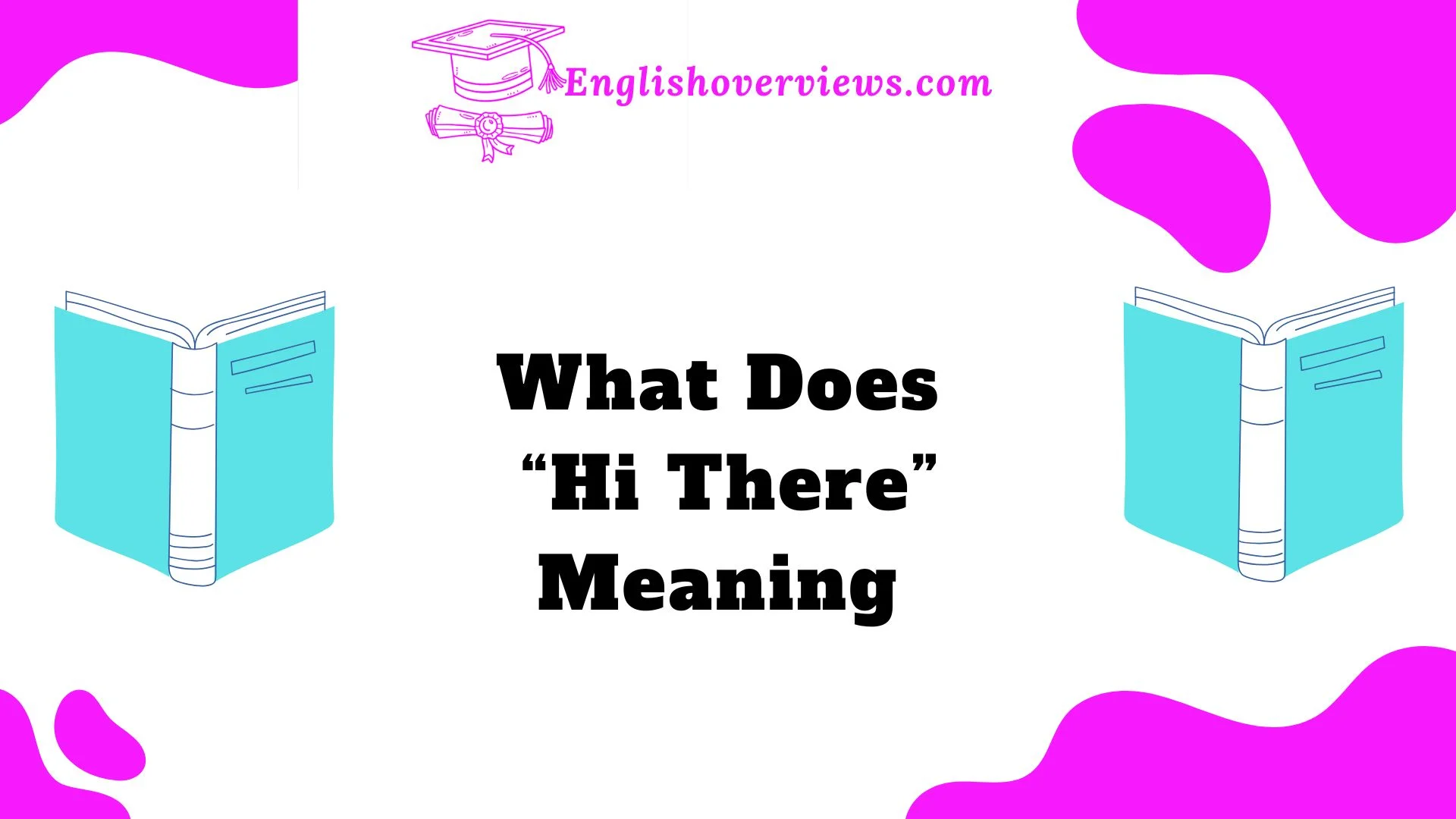Greetings are one of the most fundamental parts of communication. Whether you’re starting an email, a text, or an in-person conversation, the way you say hello shapes the tone of the interaction.
Among the many greetings people use, “Hi There” stands out as both casual and versatile. But have you ever stopped to think about what it really means, where it came from, and how it fits into today’s conversations?
This blog post will unpack the history, meaning, and impact of this two-word greeting. We’ll explore how “Hi There” has evolved, where it fits in modern communication, and when it’s appropriate to use.
Along the way, you’ll find examples, case studies, and real-world applications to help you master this simple but powerful phrase.
By the end of this deep dive, you’ll know whether “Hi There” belongs in your vocabulary or if there are better alternatives for specific scenarios. Let’s get started!
The Origins and Evolution of “Hi There”
Where Did “Hi There” Come From?
The phrase “Hi There” didn’t just appear out of thin air. Its roots can be traced back to the 19th century, when “hi” emerged as an informal greeting in English. According to linguists, “hi” evolved from older expressions like “hoy” and “hey,” which were used to catch someone’s attention.
Fun Fact:
The word “hi” first appeared in written records around 1862, during the American Civil War. Soldiers used it as a friendly, informal way to greet one another. Over time, “hi” became a staple in the English language, particularly in the United States.
The addition of “there” likely came later, as a way to soften the greeting and make it feel more personal. Adding “there” makes the phrase sound more engaging and less abrupt almost as if the speaker is acknowledging the other person’s presence directly.
How “Hi There” Evolved Over Time
Language evolves with culture, and “Hi There” is no exception. In the early 20th century, the phrase gained traction in American popular culture, thanks in part to its use in movies, TV shows, and literature. By the mid-1900s, it was a common greeting in casual conversations, often used to express warmth and friendliness.
A Brief Timeline:
| Era | Development |
| 1800s | “Hi” emerges as a variation of “hey.” |
| Early 1900s | “Hi There” becomes a casual greeting. |
| Mid-1900s | Popularized in American media. |
| 21st Century | Widely used in texts, emails, and chats. |
Breaking Down the Phrase: What “Hi There” Really Means
Why Add “There”?
The word “there” in “Hi There” adds a layer of subtlety and warmth. It’s almost as if you’re acknowledging the presence of the other person, making the greeting feel more directed and personal. Without “there,” the greeting might feel too abrupt or impersonal.
For example:
- “Hi”: Simple, neutral, and direct.
- “Hi There”: Friendly, warm, and slightly more engaging.
Psychological Insights Into the Phrase
From a communication psychology perspective, “Hi There” works because it balances familiarity and approachability. It conveys friendliness without being overly formal, which makes it suitable for a wide range of contexts.
Key Takeaways:
- Approachable tone: The phrase invites a response, encouraging dialogue.
- Personal touch: Adding “there” makes the greeting feel more targeted.
- Neutral formality: It strikes a balance, making it versatile.
Practical Examples of “Hi There” in Everyday Use
How “Hi There” Is Used Today
Let’s explore some practical examples of how people use “Hi There” in different contexts:
- Casual conversations:
“Hi there! Long time no see. How have you been?” - Work emails:
“Hi there, I hope this message finds you well. Let’s discuss the project timeline.” - Customer support chats:
“Hi there! How can I help you today?” - Introductions:
“Hi there, I’m [Your Name]. Nice to meet you!”
Real-World Examples:
Case Study: A Successful Email Campaign
A marketing agency conducted an experiment to test the effectiveness of different greetings in email subject lines. Emails that started with “Hi There” had a 20% higher open rate compared to those with more formal greetings like “Dear Sir/Madam.” Why? Because “Hi There” felt personal and approachable, which encouraged recipients to engage.
Regional Variations
Depending on where you are, “Hi There” may carry slightly different connotations:
- United States: Common in both casual and semi-formal contexts.
- United Kingdom: Seen as informal, more suitable for casual chats.
- Australia: Often used alongside other colloquialisms like “G’day.”
Appropriateness in Different Settings
Where Does “Hi There” Fit?
One of the best things about “Hi There” is its versatility. However, it’s not always the right choice. Below is a quick guide to help you decide:
| Setting | Appropriate? | Why? |
| Informal conversations | ✅ Yes | It feels warm and friendly. |
| Work emails | ✅ Sometimes | Suitable for informal workplace communication. |
| Formal settings | ❌ No | Too casual for formal occasions like legal documents. |
Adjusting for Relationships
The appropriateness of “Hi There” also depends on your relationship with the recipient.
- Close friends: Works well and feels natural.
- Professional contacts: Use cautiously; consider the workplace culture.
- Strangers: Might feel too informal opt for “Hello” instead.
The Use of “Hi There” in Professional Communication
Does It Work in the Workplace?
“Hi There” can be effective in professional settings, especially in industries that value a more relaxed communication style. For instance:
- Startups: A casual greeting aligns with their informal culture.
- Customer service: It makes interactions feel more personal and less robotic.
Example:
In an email to a colleague:
“Hi there, I just wanted to follow up on the report you submitted. Let me know if you need any additional feedback.”
When to Avoid It
However, “Hi There” might not work in highly formal industries like law or finance, where traditional greetings like “Dear [Name]” are preferred.
Responding to “Hi There”
How to Reply
When someone greets you with “Hi There,” your response should match the tone and context. Here are a few examples:
- Casual chat:
“Hi there! How’s it going?” - Professional email:
“Hi there, thank you for reaching out. I’ll get back to you shortly.”
Social and Psychological Impacts of “Hi There”
Why It Works
“Hi There” fosters positive connections by making the speaker seem approachable. According to communication experts, greetings that feel personal can enhance relationships and improve conversational outcomes.
The Modern Evolution of Greetings
How Technology Shapes Language
The rise of digital communication has transformed the way we use greetings. In emails, texts, and social media messages, “Hi There” is a go-to phrase for its simplicity and friendliness.
A Quick Comparison:
| Greeting | Tone | Best Used For |
| Hi | Neutral | General conversations. |
| Hi There | Friendly | Emails, chats, and introductions. |
| Hello | Formal | Professional or formal settings. |
Predictions for the Future
As technology continues to evolve, phrases like “Hi There” will likely remain popular, but we may see new variations influenced by emojis, GIFs, and other digital trends.
Conclusion
“Hi There” is more than just a casual greeting. It’s a versatile phrase that balances approachability and professionalism, making it a great choice for a wide range of situations. By understanding its origins, meaning, and usage, you can confidently incorporate it into your communication toolkit.
FAQs
1. Is “Hi There” too informal for work emails?
Not necessarily it depends on the workplace culture. In informal environments, it works well.
2. Can “Hi There” be considered flirty?
It’s typically friendly, but the context and tone can make it seem flirty.
3. What’s the best alternative to “Hi There”?
Consider “Hello,” “Hi,” or “Good Morning” based on the context.
4. Is “Hi There” outdated?
No, it’s still widely used in modern communication.
5. How can I make my greetings more engaging?
Personalize them! Use the recipient’s name or add a friendly question.

English Overviews is a resourceful website dedicated to providing valuable content related to grammar and vocabulary. Muhammad Haroon has made notable contributions, sharing insights on various subjects, including WordPress themes and plugins. The primary goal of the site is to help users improve their English language skills effectively.











